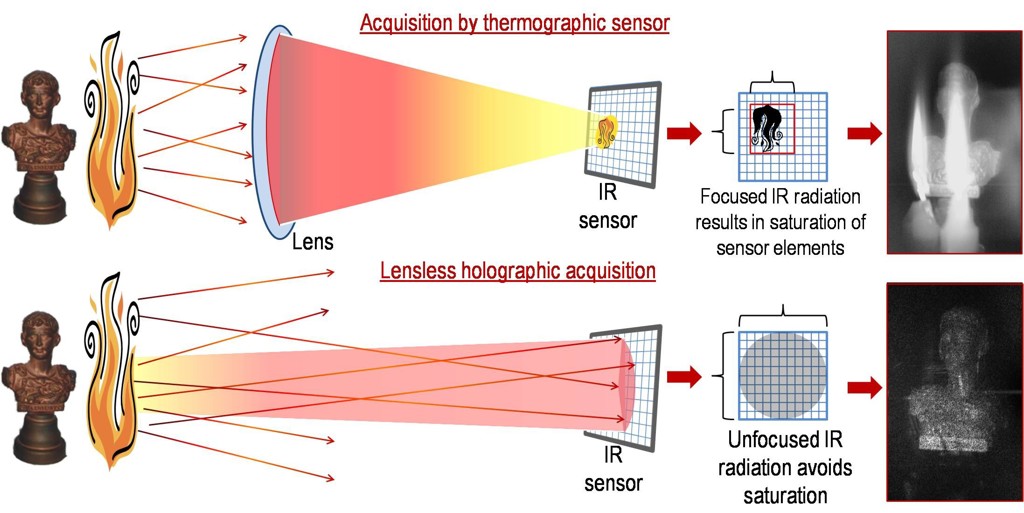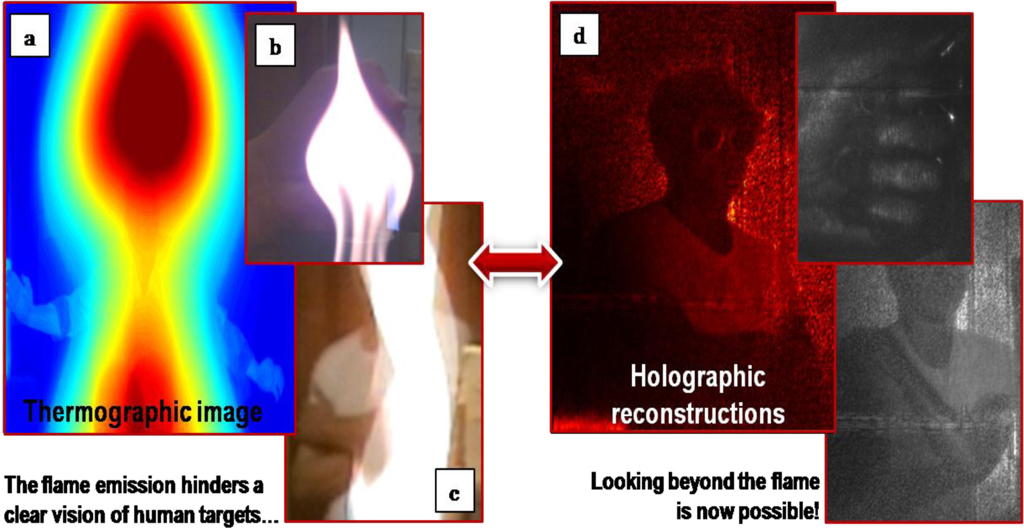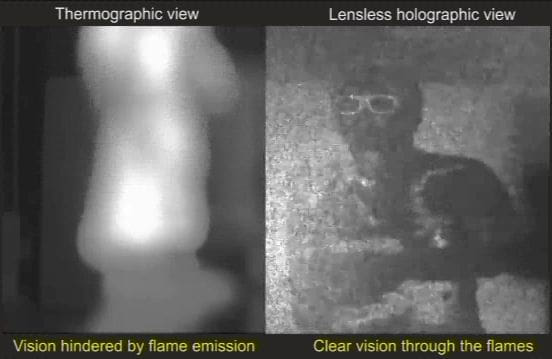Infrared Digital Holography Allows Firefighters to See Through Flames, Image Moving People
About
26 February 2013
Infrared Digital Holography Allows Firefighters to See Through Flames, Image Moving People
FOR IMMEDIATE RELEASE
Contact:
Lyndsay Meyer
The Optical Society
+1.202.416.1435
lmeyer@osa.org
Infrared Digital Holography Allows Firefighters to See Through Flames, Image Moving People

To see through smoke, scientists employ lenses to collect and focus light, but using the same technique with flames results in saturation in some areas of the resulting image (top). The new system does not employ a lens, so collected light is distributed over the whole array of camera pixels, avoiding this saturation and the blind spots it produces (bottom). Credit: Credit: Optics Express.

Two images of a live human subject as seen through flames. When viewed in infrared or white light, the man is almost completely occluded (left). The new system reproduces the image behind the flames using holography, revealing a man wearing a t-shirt and glasses (right). Credit: Optics Express.
 VIDEO: A side-by-side comparison of a traditional imaging system, in which the view of a man is obstructed by flames, and the new technique, in which the viewer can see the man standing and waving his hand. Credit: Optics Express.
VIDEO: A side-by-side comparison of a traditional imaging system, in which the view of a man is obstructed by flames, and the new technique, in which the viewer can see the man standing and waving his hand. Credit: Optics Express.Firefighters can see through smoke using current IR camera technology. However, such instruments are blinded by the intense infrared radiation emitted by flames, which overwhelm the sensitive detectors and limit their use in the field. By employing a specialized lens-free technique, the researchers have created a system that is able to cope with the flood of radiation from an environment filled with flames as well as smoke.
“IR cameras cannot ‘see’ objects or humans behind flames because of the need for a zoom lens that concentrates the rays on the sensor to form the image,” says Pietro Ferraro of the Consiglio Nazionale delle Ricerche (CNR) Istituto Nazionale di Ottica in Italy. By eliminating the need for the zoom lens, the new technique avoids this drawback.
“It became clear to us that we had in our hands a technology that could be exploited by emergency responders and firefighters at a fire scene to see through smoke without being blinded by flames, a limitation of existing technology,” Ferraro says. “Perhaps most importantly, we demonstrated for the first time that a holographic recording of a live person can be achieved even while the body is moving.”
Holography is a means of producing a 3-D image of an object. To create a hologram, such as those typically seen on credit cards, a laser beam is split into two (an object beam and a reference beam). The object beam is shone onto the object being imaged. When the reflected object beam and the reference beam are recombined, they create an interference pattern that encodes the 3-D image.
In the researchers’ new imaging system, a beam of infrared laser light is widely dispersed throughout a room. Unlike visible light, which cannot penetrate thick smoke and flames, the IR rays pass through largely unhindered. The IR light does, however, reflect off of any objects or people in the room, and the information carried by this reflected light is recorded by a holographic imager. It is then decoded to reveal the objects beyond the smoke and flames. The result is a live, 3-D movie of the room and its contents.
The next step in moving this technology to the field is to develop a portable tripod-based system that houses both the laser source and the IR camera. The systems may also be suitable for fixed installation inside buildings or tunnels. In addition, the team is exploring other applications, most notably in the biomedical field for non-destructive testing of large aerospace composite structures.
“Besides life-saving applications in fire and rescue, the potential to record dynamic scenes of a human body could have a variety of other biomedical uses including studying or monitoring breathing, cardiac beat detection and analysis, or measurement of body deformation due to various stresses during exercise,” Ferraro says. “We are excited to further develop this technology and realize its application for saving and improving human life.”
Paper: “Imaging live humans through smoke and flames using far-infrared digital holography,” M. Locatelli et al., Optics Express, Vol. 21, Issue 5, pp. 5379-5390 (2013).
EDITOR’S NOTE: Images and a movie of the new technique are available to members of the media upon request. Contact Lyndsay Meyer, lmeyer@osa.org.
About Optics Express
Optics Express reports on new developments in all fields of optical science and technology every two weeks. The journal provides rapid publication of original, peer-reviewed papers. It is published by the Optical Society and edited by Andrew M. Weiner of Purdue University. Optics Express is an open-access journal and is available at no cost to readers online at www.OpticsInfoBase.org/OE.
About OSA
Uniting more than 180,000 professionals from 175 countries, the Optical Society (OSA) brings together the global optics community through its programs and initiatives. Since 1916 OSA has worked to advance the common interests of the field, providing educational resources to the scientists, engineers and business leaders who work in the field by promoting the science of light and the advanced technologies made possible by optics and photonics. OSA publications, events, technical groups and programs foster optics knowledge and scientific collaboration among all those with an interest in optics and photonics. For more information, visit www.osa.org.
